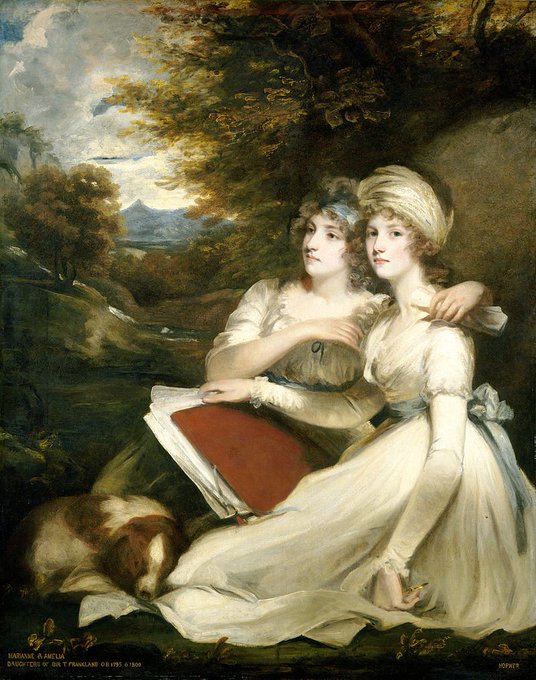fashionhisのTwitterイラスト検索結果。 313 件中 8ページ目
I adore Marjorie Post but in this week's #MerriweatherMonday, we see how dressing up can sometimes go too far. In 1929, she went as an "American Indian" to a Fancy Dress Ball. Today cultural appropriation is a big topic around dressing up and Halloween especially #FashionHistory
Today’s #cotd is a fancy dress costume from 1820. It’s an interesting regency interpretation of the renaissance, made of satin, glaze and silver trimmings. @KerryTaylorAuct #fridayfrills #fashionhistory.
In honor of my job @FieldofFirsts, today's #cotd is all to do with airplanes! There are three fashion illustrations and one excellently executed example of how aviation has been the inspiration for fancy dress since its beginning. #FashionHistory
Today's #cotd is Miss. Stevenson dressed as "Photography" to a fancy dress ball in Montreal in 1865. She took the idea from a fashion plate (like those pictured) Also, note that she is showing her ankles, something quite scandalous at the time. #FashionHistory
This week's #MerriweatherMonday features the Queen of Fancy Dress herself, Marjorie. She loved to dress as Marie Antionette and this dress was worn both in 1904 and 1924. In the second case, she won the 1st prize in the Everglades Ball. @HillwoodMuseum #FashionHistory
Today's #cotd is this 1883-87 "Gypsy" costume. It is interesting to contemplate for a woman of the 1880s could have worn this to a fancy dress ball. She, of course, would have worn stockings but this still is quite shocking! Also, love the coin trim on the bottom #FashionHistory
#Inktober2019 Day 03/31: I've concluded that I may prefer yellow roses to red ones. "Chameleon streaks enables a girl to match the color of her hair to every occasion." From "Hair Flashes" (1955).
#inktober #inkdrawing #vintagefashion #roses #fashionhistory
#Inktober2019 Day 02/31: “Reminiscent rather of Medieval headdresses, the pad - in this case, a colorful chiffon scarf - pinned under the [ponytail] brightens the effect... her necklace can be switched from her throat to the top of her hair.”
#inktober #inkdrawing #fashionhistory
This week's #FridayFrills is this 1900-05 House of Worth ball gown. This was after Jean-Philippe took over his father's business and as you can tell from the close ups, the quality and craftsmanship continued to be impeccable! #FashionHistory
Today's #ootd is a sweet 1840 American dress. This year, Queen Victoria wore a white dress when she married Albert, establishing one of the most iconic looks of all time. This dress was probably not worn as a wedding dress, but I definitely would wear it to mine. #FashionHistory
Today's #ootd is another pink dress with a floral pattern. This one though was made between 1770-1789, although the embroidery is from 1730-1750. The style is a little frumpy, but the embroidery is impeccable. @nasjonalmuseet #NorwegianNationalMuseum #FashionHistory
For #LaborDay I'd like to acknowledge all the men and women that go behind the amazing creations that I show everyday. It takes many more than the one name on the label. Here are pictures of the haute couture ateliers from the early 1900s #FashionHistory
Today's #ootd is a 1865 c. dress. It was worn by the last Empress of France, Eugene, the wife of Napoleon III. She wore this when she and her husband went on a trip to Bordeaux. Here is a picture of Eugene from 1865 as well as a portrait from her younger days. #FashionHistory
This week’s #MerriweatherMonday is a 1927-32 dress, slip, and cape, which was commissioned when she lived in NYC with husband E F Hutton. The Hillwood wrote it “captures the flair of the Art Deco period of the 1920s with its geometric patterns and bright colors.” #fashionhistory
Portrait of the Frankland sisters by John Hoppner gives an idea of the styles of 1795. Hoppner achieved fame as a brilliant colorist and first exhibited at the Royal Academy in 1780. #arthistory #fashionhistory
#Hoppner
Today's #ootd is a 1917 white muslin dress from @KSUMuseum. It is endearingly sweet and I love a good yellow sash! #FashionHistory
Eyes by Erté. Born Romain de Tirtoff in St. Petersburg in 1892, he began drawing costumes aged 5. Erté moved to Paris to work (very successfully) as a fashion illustrator & costume designer. His #ArtDeco style became popular again in the #1960s. He died in 1990.
#fashionhistory
This week’s #FridayFrills is this 1886-1887 French Evening dress by Worth and worn by Elizabeth Fenollosa. It is thought that she wore this dress to the Imperial Court of Japan, when her husband became the director of Japan’s Imperial Museum in Tokyo @philamuseum #fashionhistory
Today's #ootd is a 1795 English woman's round gown. The round gowns of the 1790s was a precursor to the regency classical style. It has the 18th century front closing bodice with a fitted back but now the waistline is higher @LACMA #FashionHistory







































































